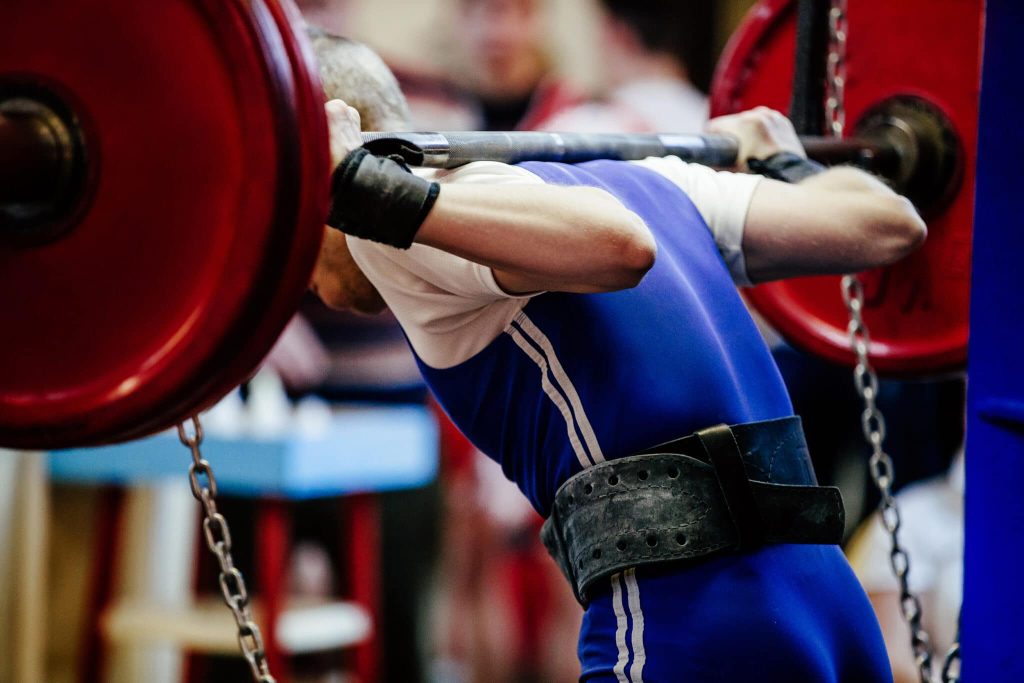Squatting is one of the best compound exercises. It not only loads the legs, but also engages the core and postural muscles in the trunk of the body. Squats further increase flexibility, improve stability, and increase coordination. It’s no wonder why many weightlifters incorporate this exercise into their regular workout routine.
The problem is that a lower back injury from squats is very common. The World Health Organization estimates 60-70% of individuals will experience back pain at some point in their life. And when back pain from squats happens, it can derail your leg day and potentially put you on the sidelines for days – if not, weeks. The last thing any athlete or weightlifter wants is to put their training goals on hold. So, what should you know?
In this article, we’ll dive into how and why squatting leads to a lower back injury, what you should do if you notice back pain during your squats, and how you can bounce back after a low back injury.
Quick Navigation
How Squatting Can Lead to Lower Back Injuries
What To Do If You Are Noticing Back Pain From Squats
How to Recover From Lower Back Injuries Related to Squatting

How Squatting Can Lead to Lower Back Injuries
In any exercise, your technique is key. In fact, incorrect form is a sure-fire way toward increasing your risk of injury and pain. Thus, being aware of your form throughout the entirety of each exercise is crucial to preventing pain.
When it comes to squatting, this means keeping your chest up and your back in a neutral position during the descent and ascent. Ideally, you want to brace your core, which means activating your abdominals before beginning the exercise and continuing to keep them engaged throughout the movement.
Read Also: Top 5 Best Deadlift Shoes
By engaging the core muscles, such as the glutes and abdominals, you’ll provide your low back with the support it needs to maintain proper alignment. This also loads the body correctly, preventing other muscles from compensating and preventing poor posture. When other muscles compensate, you may end up with a strained, or pulled, muscle causing pain.
Ideally, you want to activate your quadriceps, hamstrings, glutes, core, and postural muscles during the squat.
Another key piece many individuals overlook is the activation of the upper back. You want to engage the lats to prevent rounding or hunching. Again, this also loads the correct muscles, protecting your low back.
Other reasons back pain may occur during your squat include a lack of ankle mobility, adding too much weight too quickly, or poor footwear. Ankle mobility limits your squat depth. It may also cause your knees to protrude past your toes, which can create some issues as well. Additionally, too much weight means your body has not been able to adapt. This is why progressive overload for weight lifting is important. Your body needs time and a gradual increase in load to get stronger.
Related Read: The Ultimate Guide To Improve Ankle Mobility
Lastly, poor footwear may not provide enough support for the arch of your foot. Interestingly, your foot or ankle mechanics can cause a chain reaction. This means other joints and muscles of the body may not function at their best when they are attempting to compensate for another problem, such as the feet or ankle.
So, what muscles are you activating during your squat?
Related Read: Top 3 Best Knee Wraps For Squats And Powerlifting
Generally, your quadriceps, hamstrings, and glutes are the prime movers. This leaves your core, like the abs, and your postural muscles, like the lats, traps, and erector spinae muscles, as your accessory muscles. However, don’t let the word ‘accessory’ throw you off. As mentioned above, these muscles play a significant role in proper form and lower back injury prevention.
What To Do If You Are Noticing Back Pain From Squats
The problem: You’ve already experienced back pain after or during squats. And it hasn’t gone away. Now, what?
If at any point you feel back pain from squats, stop the exercise. If the pain ebbs off, consider adjusting and checking your form. You can ask a friend to watch or use a mirror. Ensure your back remains neutral – no hunching – and that your knees don’t travel past your toes. You also want to check your knees and make sure they stay in line with your ankles – without them caving inward.
Related Read: Pistol Squat Progressions – Get Super Strong Legs with this One Calisthenics Exercise
If the pain still happens, take a break. Try a different squat form or squats without weight (at least for this session). And if the pain continues throughout your workout, that’s a sign you need to rest. Consider going home and icing your lower back as needed.
If you happen to continue training, stick to exercises that don’t cause pain. This may mean not using weights for the time being or sticking to more isolated and isometric movements, as opposed to compound movements.

The Best Calisthenic Core and Abs Workouts
In fact, back barbell squats are the more advanced squat movement. You may want to try goblet squats, holding a kettlebell or weight in front, or front squats until your lower back pain resolves. Doing core movements, specifically exercises that target your transverse abdominals, may also help during healing and recovery. These exercises will also ensure injury and pain doesn’t happen again.
How to Recover From Lower Back Injuries Related to Squatting
Squat back pain isn’t ideal, especially if you’re working toward some ambitious goals. Yet, it happens. And recovery revolves around resting and healing, as well as preventing future pain.
So, what can you do to get back into the gym ASAP?
First off, don’t rush it. If you head back into squatting again too early, you may risk increased pain and a worse injury. Take the appropriate amount of time your body needs. Most cases of back pain resolve within six weeks or less.
Instead, focus on what you can do. Perform the exercises that don’t aggravate your pain. Add in new exercises to help in healing and future prevention.

Benefits of the Wall Squat: Under Estimated Lower Body Exercise
Surprisingly, you might be squatting sooner than you think. Wall squats are typically some of the first squat variations you should try while your back heals. Yet, before you get to squats, we recommend focusing on your transverse abdominals and other core muscles.
Focusing On The Transverse Abdominals
The transverse abdominals, or TA muscles, are the deeper and lower abs. Interestingly, a person can have a weak TA muscle, yet still, have a 6-pack. The TA muscles aren’t visible. But they are important! These muscles help stabilize the pelvis and low back. In women, they also play a significant role in childbirth.
Many individuals neglect the TA muscle. There isn’t an aesthetic reason to strengthen them, so they don’t. Or they don’t know what they are, so they don’t.
But the TA muscle is frequently the main ingredient missing when it comes to preventing future injury and bouncing back after back pain.
If you’re new to strengthening this muscle, try this quick daily exercise:
- Lay face-up with your knees bent and your feet flat on the ground.
- Imagine a tightrope around your hip bones or stopping the flow of urine – whichever works.
- You can feel the TA muscles tightening by pressing your fingers in between your hip bones.
- Hold this contraction for 5-10 seconds, and repeat for 8-10 reps and 2-3 sets per day.
Read Also: Knee Wraps vs Knee Sleeves – Know when to use each
Once this exercise becomes easy, add in leg movements. Start by straightening one leg and slowly lowering it to the ground then back up. Eventually, you can progress to lifting both legs.
Working On Your Flexibility
If ankle mobility seems to be a problem, incorporate ankle mobility stretches and mobility work into your routine. If hamstring flexibility is holding you back, again, focus on stretching these muscles.
A 2016 study showed that a combination of core strengthening exercises and lumbar flexibility exercises may be best when recovering from a low back injury.
Read Also: Top 6 Best Self Myofascial Release Tools
For instance, practicing yoga moves, such as the upward dog, may help improve your lumbar spine flexibility and mobility. The upward dog involves laying face-down and pressing up into your hands and straightening your arms so that your lower back is flexed. In combination with this move, you should also consider the child’s pose exercise. This is almost the opposite of the upward dog. If you begin on all-fours, you simply bring your buttocks back to your heels, resting the rest of your body on your legs and the ground.

Conclusion
If the pain persists for longer than a few days, consider booking an appointment with your local physical therapist. They can help create a treatment plan and exercise rehab program suited to you and your specific needs. By following the above advice or that of your physical therapist, you should be able to bounce back from pain and get back in the gym as soon and as safely as possible!

